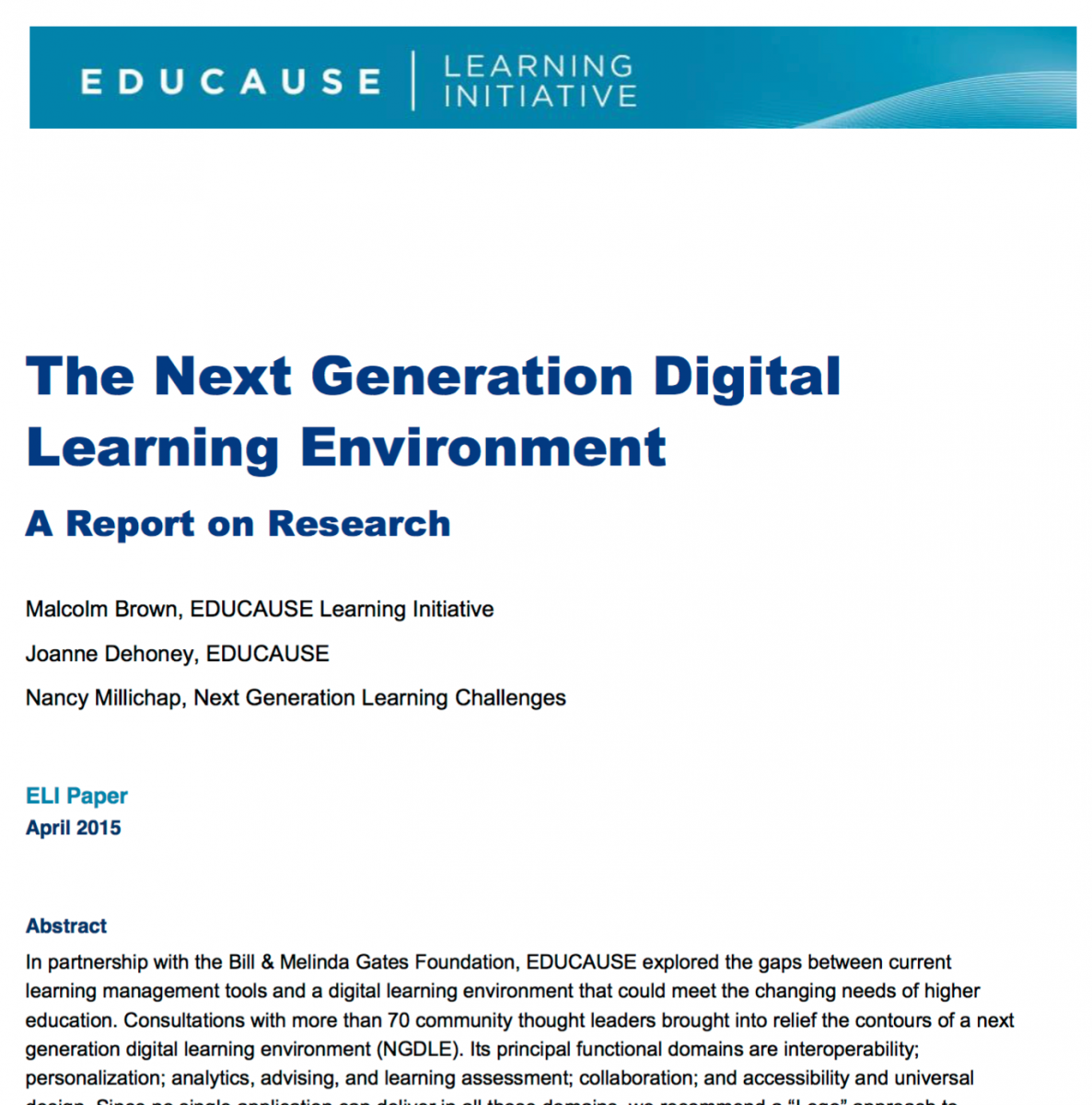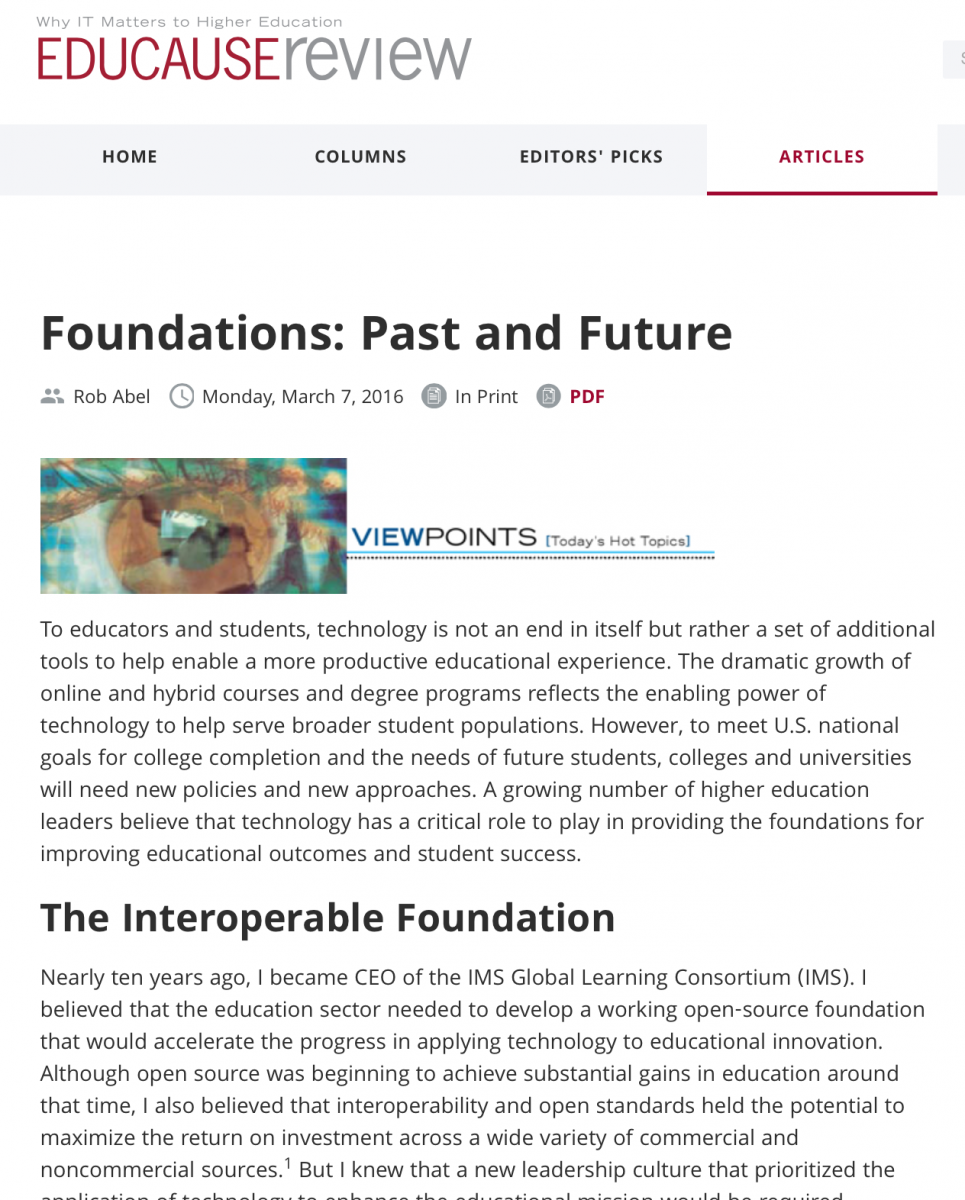#1 of a series
There is a lot of excitement and curiosity regarding the concepts introduced in the EDUCAUSE Learning Initiative (ELI) research paper on the Next Generation Digital Learning Environment (NGDLE), which was based on focus group interactions with some 50-100 higher education edtech leaders. I attended most of the focus group sessions myself, which also had great representation from 1EdTech member organizations.
 The plenary sessions for the upcoming May 2016 Learning Impact Leadership Institute are going to focus entirely on next generation digital learning. I am writing a series of short topic blog posts beginning this week for the next several weeks with some of my thoughts on next generation digital learning environments to help get ready for the big event. In this weekly blog series I want to write about how I am thinking about NGDLEs – with the hopes of spurring thoughts from others inside and out of the 1EdTech community.
The plenary sessions for the upcoming May 2016 Learning Impact Leadership Institute are going to focus entirely on next generation digital learning. I am writing a series of short topic blog posts beginning this week for the next several weeks with some of my thoughts on next generation digital learning environments to help get ready for the big event. In this weekly blog series I want to write about how I am thinking about NGDLEs – with the hopes of spurring thoughts from others inside and out of the 1EdTech community.
The LILI16 plenary lightning talks will be grappling with the concepts and the realities of next generation digital learning. And, in true 1EdTech fashion, we will also be hearing from a panel of institutional leaders to get their pragmatic take on everything that was said.
So, what would I like to cover in this first post of the series? I want to cover a bit on the road that led us here and the road ahead.
One of the cool things about the work of 1EdTech is that while we are improving connectivity of edtech products today we are also establishing the foundation for better connectivity of learning apps, platforms, and resources for tomorrow. This point is brought home in the ELI NGDLE research paper:
- Interoperability is the linchpin of the NGDLE. The ability to integrate tools and exchange content and learning data enables everything else.
- At the built layer, the NGDLE will be a confederation of IT systems, including content repositories, analytics engines, and a wide variety of applications and digital services. One key to making such a confederation work will be full adherence to standards for interoperability, as well as for data and content exchange.
 In a recent EDUCAUSE Review Viewpoints column entitled Foundations: Past and Future I describe how the NGDLE follows a prior paper helping to set the stage entitled A New Architecture for Learning. In the same column I highlight several of the most promising areas of interoperability for the NGDLE, which I will summarize here:
In a recent EDUCAUSE Review Viewpoints column entitled Foundations: Past and Future I describe how the NGDLE follows a prior paper helping to set the stage entitled A New Architecture for Learning. In the same column I highlight several of the most promising areas of interoperability for the NGDLE, which I will summarize here:
- Seamless integration of learning apps and learning platforms: Arguably, without the success so far of Learning Tools Interoperability (LTI) it is unlikely we would take seriously the idea that the NGDLE could be a “confederation of systems” that can be “mashed-up” by users. However, LTI has some road to travel to fully support the NGDLE.
- Publishing, sharing and finding learning apps & resources: What is the success model for this today in the consumer app world? Allegiance to a single platform from a pretty limited set of platforms. In education, how do we leverage the power of LTI with truly cross-platform curating of educational resources?
- Cross-application learning analytics: Confederation of systems sounds great. But to enable better learning we need confederation of actionable data and information.
- Accessibility and personalization: To support accessibility and personalization across a confederation of apps and systems there needs to be a common language across those systems describing accessibility and personalization needs and capabilities.
The summary? NGDLE requires cross-platform and cross-application integration that goes way beyond what is typically happening today in either higher education or K-12 IT departments.
Despite the successes of standards like LTI to date, there should not be any irrational exuberance about the likelihood of magical interoperability that will enable NGDLE tomorrow. Instead, we need to consider carefully where we are going and how we are going to get there – taking into account the realities of the edtech sector. Thinking through that path is what this blog series is all about.
Next up in the series: What is the right metaphor for thinking about Next Generation Digital Learning Environments? See you then.


